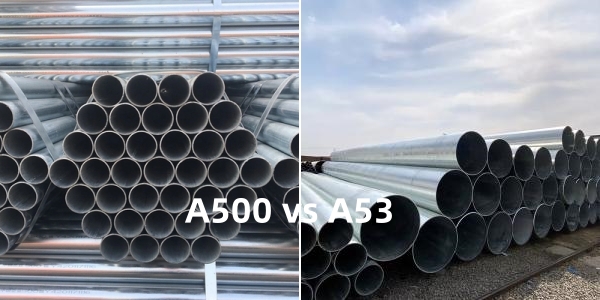ASTM A53 serves as the standard specification for welded and seamless steel pipes, typically coated with black paint, designed for applications involving mechanical use, pressure, as well as the conveyance of general fluids such as steam, water, and air. On the other hand, ASTM A500 is the established standard specification for cold-formed carbon steel structural pipes, available in both welded and seamless varieties, specifically intended for building and structural purposes. Now, let's delve into the disparities between ASTM A53 and A500 steel pipes.

1. Purpose and Application:
ASTM A500: This standard specifically covers cold-formed welded and seamless carbon steel structural tubing. It is primarily intended for use in structural applications, such as building construction, architectural components, and general structural support. ASTM A500 is not suitable for pressure and mechanical applications.
ASTM A53: ASTM A53, on the other hand, covers seamless and welded black and hot-dipped galvanized steel pipe. It is primarily used for conveying fluids and gases, making it suitable for applications such as water supply, natural gas pipelines, and general-purpose plumbing. ASTM A53 is also used in mechanical and pressure applications, particularly in industrial settings.
2. Manufacturing Process:
ASTM A500: The steel tubing covered by ASTM A500 is typically cold-formed, which means it is produced by bending and shaping flat steel sheets or coils at room temperature without the use of heat. This process results in a variety of shapes and sizes for structural purposes.
ASTM A53: The pipes specified by ASTM A53 can be either seamless or welded. The manufacturing process for A53 pipes can involve either hot-rolling (for seamless) or electric resistance welding (for welded), and they are often galvanized for corrosion resistance.
3. Grades:
ASTM A500: ASTM A500 has several grades, including Grade A, Grade B, and Grade C, which have different yield strengths. The choice of grade depends on the specific structural requirements.
ASTM A53: ASTM A53 is not divided into grades like ASTM A500. It is generally specified by its type and grade, which can be either Type E (electric-resistance-welded) or Type S (seamless), and Grade A or Grade B.
4. Corrosion Resistance:
ASTM A500: While ASTM A500 steel can be used in outdoor applications, it is not specifically designed for superior corrosion resistance. If corrosion resistance is a significant concern, additional protective coatings may be required.
ASTM A53: ASTM A53 pipes are often galvanized to provide excellent corrosion resistance, making them suitable for outdoor and exposed applications.
In summary, ASTM A500 is intended for structural applications and is produced through cold forming, while ASTM A53 is used for conveying fluids and gases and is available in both seamless and welded forms, with an emphasis on corrosion resistance in some cases. The choice between them depends on the specific application and requirements of the project.

 English
English Español
Español




 Tel : +86-18565811709
Tel : +86-18565811709 Email :
Email : 

 News
News




